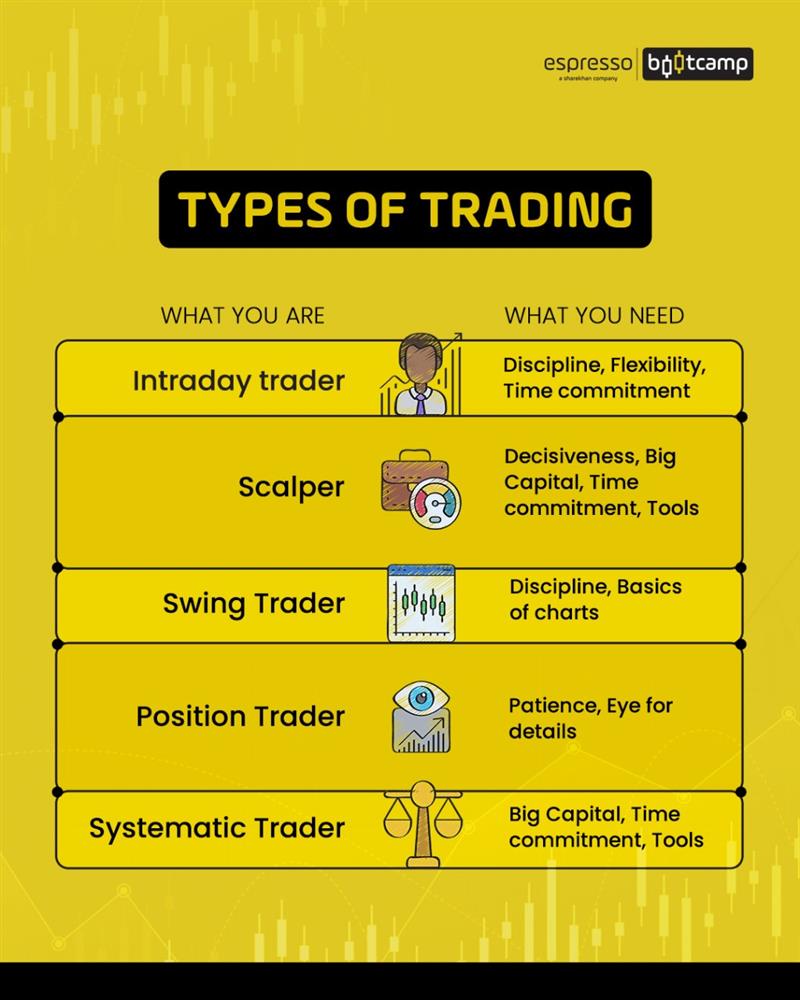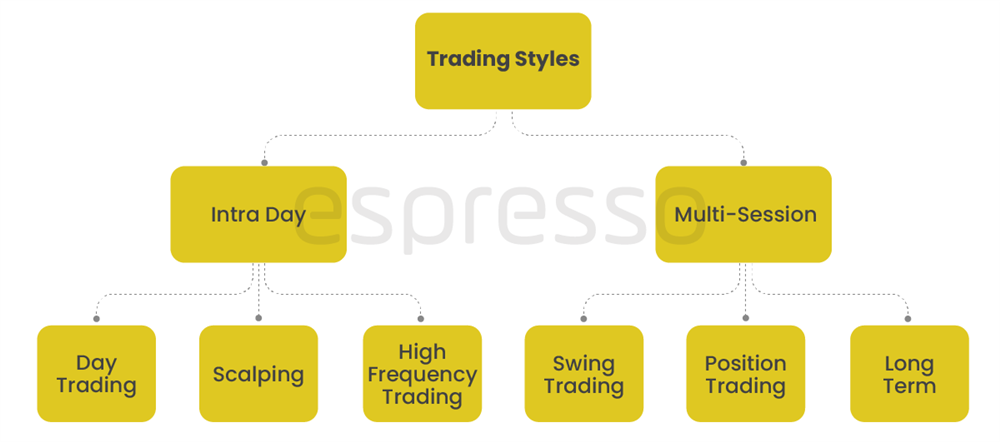
Over time, traders have developed various styles or types of trading to suit their convenience and risk-taking abilities. Trading types or styles are not mutually exclusive, meaning the adoption of one method does not bar you from adopting other trading styles. In fact, many traders go for different types of trading under different circumstances. However, sticking to your favourite style is favourable. Devote time and effort to identify your niche and then adopt a suitable trading style.

The diagram alongside illustrates the most popular types of trading in stock market or trading styles:
As you have gathered, there are broadly two types of trading:
- Intraday, meaning trades covered within a day
- Multi-session, meaning trading done over a period of time
There are three styles under each of these. Let’s take a look:
Intraday
Day Trading:
In this type of trading in stock market, all trades are commissioned and closed within one trading session, and the trader doesn’t keep any open position at the end of the day. In fact, day trading was one of the most popular ways people kept themselves busy during the Covid-19 induced lockdowns.
Among the different types of trading, professional day traders are known to take large positions, often taking advantage of leveraged margins. They take home significant returns as small price movements on large positions can result in big gains.
A word of caution: You need to guard against overtrading, as the slightest of price movements in the opposite direction can cause huge losses. You should also be well informed about the happenings in the market as those events will have a direct impact on the stock prices. You should also guard against the threat of psychological addiction to trading.
In day trading, a trader will not be able to take advantage of gap-up and gap-down openings on the next trading day. At the same time, he will be saved from the adverse impact of overnight events on the morning stock prices.
However, what may work against a day trader is the frequent costs of trading, which the trader must take into account while evaluating intraday trading as a business.
Success mantra: Day trading is a difficult process, and you should go for this type of trading only if you have the time and energy and have undertaken a minimum learning curve.
Scalping:
Scalping is a type of trading in which traders buy and sell in very short periods of time with the aim of making a small profit. The time gap of each trade may range between a few seconds and a few minutes. Like day traders, scalpers also don’t take overnight positions.
One of the most common methods of scalping is buying at the Bid price and selling at the Ask price and making a quick profit out of the difference between the Bid/Ask price. Scalpers rely more on technical analysis than fundamentals. They hold positions only for a short duration, and as such, the chances of suffering huge losses from wide and sharp fluctuations in prices are remote.
Since the amount of gain in each trade is small, a scalper will have to do multiple trades in a day to earn sizeable profits. Also, as this style involves quick buying and selling, this is usually suitable for traders with small capital. Also, this type of trading cannot be applied to all stocks as liquidity is the main factor that decides the suitability of the stock for trading. Highly illiquid stocks are not ideal for scalping. Further, scalpers thrive in a stable market.
Success mantra: Traders need to be self-disciplined and should be able to overcome greed. Here, success largely depends upon your ability to predict how the price will behave in the next few moments. Also, in this type of trading, the brokerage should be nominal.
High-frequency trading:
Popularly known as HFT, it’s a type of trading in stock market where trades last just for milliseconds! Here the emphasis is on the speed of trading and is usually algorithm-based, which means using computer programs to do trades. So, the traders with the fastest execution speeds are likely to be more successful. In fact, high speeds, high turnover rates and high order-to-trade ratios that leverage high-frequency are the hallmarks of HFT. HFT traders make up for their low margins with incredibly high volumes of trades, frequently numbering in millions.
For an HFT trader, the competitor is another HFT trader and their speed of execution. Since volumes and pace are decisive factors, this has been often accused of creating existential risks for small-time traders.
Success mantra: Because of their high frequency and high volume trading, HFT traders are often blamed for high volatility in the market. At the same time, it’s also true that HFT trading provides liquidity to the market. Therefore, you can pick this style only if you have the wherewithal to support it. The competition here is also with a few large firms with very high-tech infrastructure, so one must consider all this before entering the HFT space.
Multi-session
Swing Trading:
Unlike a day trader, a swing trader holds on to their position for more than a day – several days or even weeks - as the objective here is to capture short to medium-term (spanning some weeks) gains in a stock. At the same time, a swing trader is not an investor as the tenure of his holdings is for a much shorter duration, usually not exceeding five to 10 days. If a short-term investor aims to gain, say, 25% in five to six months, a swing trader looks for maximum profit in the shortest possible time, say 3-5% in a few hours.
A swing trader aims to make a profit either by buying stocks or short-selling them to capitalise on the upward and downward ‘swings’ in the price of a security. The trader seeks help from various types of indicators to take positions. The most commonly used indicators are moving average (short-term MA crossing over long-term MA), volume (to assess the strength of ongoing trend), Relative Strength Index (to find out overbought and oversold zones), stochastic oscillator and ease of movement indicator.
Success mantra: This type of stock trading works well when the stock is either rising or falling and is ineffective during sideways movements. Your ability to keep losses small by judiciously adopting a stop-loss strategy is key to success in this style.
Swing trading is tough to master, but someone who is able to adapt to this style and stick to it can reap huge rewards. It gives high returns in very short spans of time compared to position trading.
Position Trading:
This is a leisured class trading in which a trader holds onto his position for several weeks or longer. A position trader takes a position after the stock has established itself as a trend and exits the position when the trend breaks.
Position trading is different from swing trading in the sense that the amount of time involved between buying and selling is much longer in the former.
Success mantra: A position trader relies on general market trends and long-term historical patterns to take a particular position. In this type of stock trading, the trader takes the help of both technical and fundamental analyses to take a position in the stocks. A 200-day moving average is the most commonly used analytical tool by position traders.
Long-term Investing:
This is not a trading strategy but an investment method commonly adopted by those who want to invest their surplus funds in stocks but don’t have time to monitor them regularly. Here the objective is not to earn quick profit from short-term movements but to gain through holding the stocks for a longer duration, maybe for years. In the process, investors also gain from dividends, bonus issues, stock splits and buybacks. They usually expect a better return from stock investing than from fixed-return investments like fixed deposits.
Success mantra:Buy good stocks and hold them for a long time.
Points to remember:
- Trading styles are not mutually exclusive; you can adopt different trading types at the same time.
- All the different types of trading have their pros and cons.
- You must opt for a suitable style depending on your financial strength, the time you can devote and your skills.
 0
|
0
|
 0
0
 Modules
Modules

 Watch
Watch 
